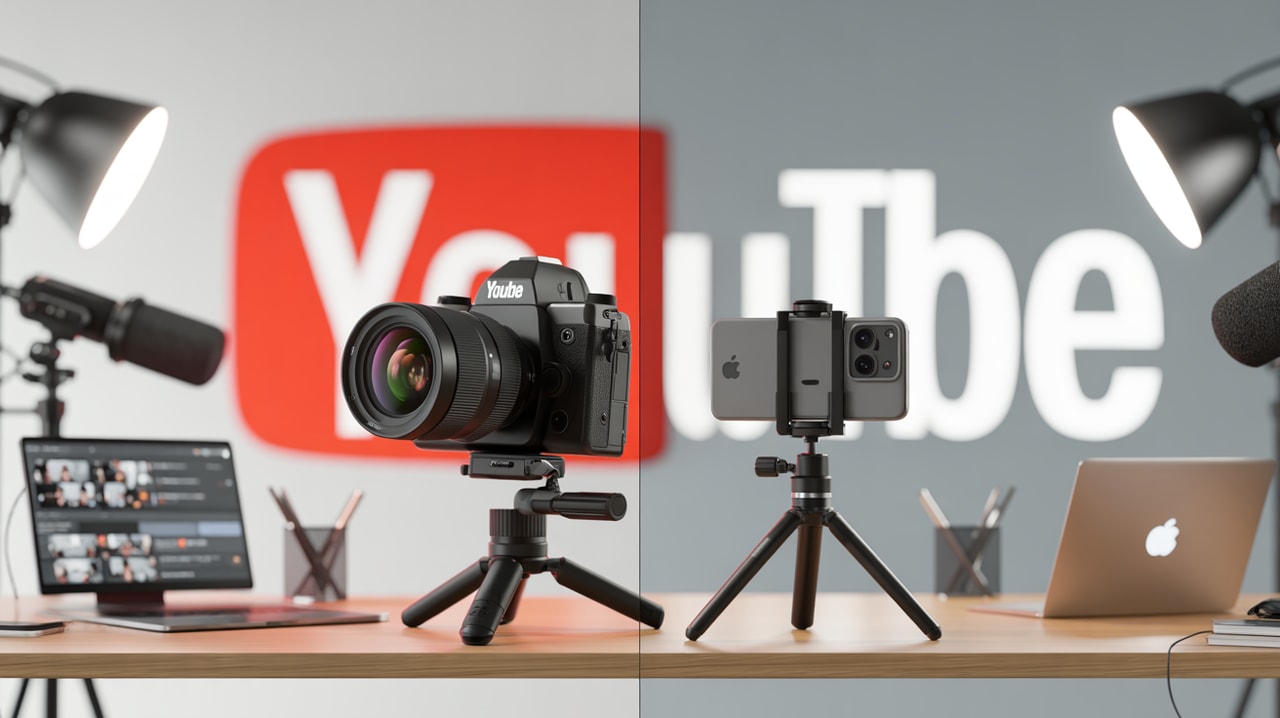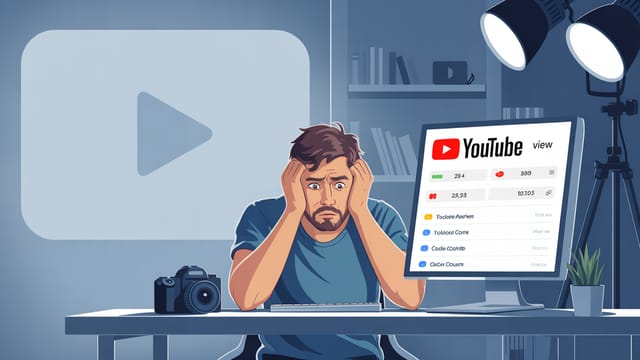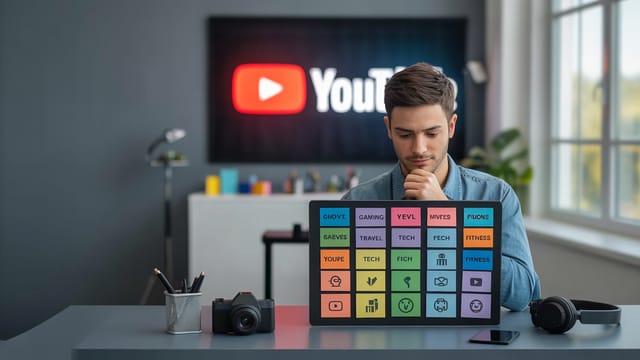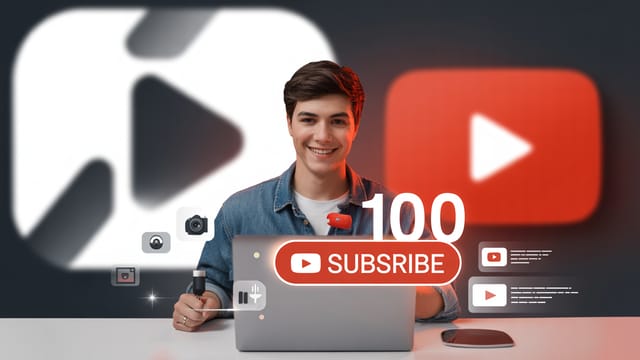
Ready to get your next 10,000 subscribers?
Join thousands of creators who use Subscribr to create faster, better YouTube videos.
How Important is Expensive Camera Gear for YouTube Success? (A Deep Dive)
It's a question that plagues nearly every aspiring YouTuber: "Do I need an expensive camera to succeed?" You see creators with stunning 4K footage, buttery-smooth bokeh, and think, "I can't compete with my smartphone or basic setup." This feeling often leads to "Gear Acquisition Syndrome" (GAS) – an urge to buy expensive equipment you might not actually need, especially when you're just starting out.
The truth is, while production quality matters, the camera body itself is often the least important part of the equation, particularly when you're focused on growth. Investing heavily in a high-end camera before you've even figured out your content strategy, audience, and basic video production skills is like buying a Formula 1 car before you know how to drive.
This article will provide a nuanced perspective for creators fixated on top-tier gear, emphasizing a holistic view of what truly drives YouTube growth. We'll address the pain points of perceived high cost, misalignment of gear with content goals, and the sheer information overload when choosing equipment.
What Factors Are More Important Than Camera Quality on YouTube?
While a crisp, clear image is certainly a plus, it pales in comparison to several other crucial factors that influence YouTube success:
- Content Value: This is king. As many successful creators will tell you, valuable content always beats expensive equipment. You can have the most beautiful footage in the world, but if your content is boring, uninformative, or doesn't resonate with your target audience, people won't watch. Conversely, millions of viral videos have been shot on smartphones because they deliver immense value, entertainment, or a unique perspective. Focus on solving a problem, teaching a skill, or genuinely entertaining your viewers.
- Storytelling and Pacing: A compelling narrative or a well-structured video that keeps viewers engaged is far more impactful than pixel count. Understanding how to hook your audience in the first few seconds, maintain pacing throughout the video, and deliver a satisfying conclusion is a skill that transcends gear. Learning how to "paint" a good video is more important than having expensive "brushes."
- Audio Quality: This is arguably more important than video quality. Viewers are often more forgiving of less-than-perfect video if the audio is crystal clear. Poor audio can make a video unwatchable, regardless of how good the visuals are. Investing in a decent microphone should often be a higher priority than upgrading your camera body.
- Lighting: Good lighting can make even a budget camera look significantly better. Natural light from a window is a free and effective starting point. As you grow, investing in a simple lighting setup (like a softbox or ring light) will have a more noticeable impact on your video quality than a camera upgrade.
- Editing: The editing process is where your video truly comes together. Good editing can hide imperfections, improve pacing, add visual interest, and enhance your storytelling. Learning effective editing techniques is a vital skill that influences the final perceived quality of your video more than the camera it was shot on.
- Thumbnail and Title: These are your video's first impression. A compelling thumbnail and title are crucial for getting viewers to click in the first place. You can have the best content in the world, shot on the most expensive camera, but if no one clicks, it doesn't matter.
- Audience Engagement and Retention: YouTube's algorithm heavily favors videos that keep viewers watching and engaging. Focusing on creating content that resonates with your target audience and encourages likes, comments, and shares is paramount. This is about understanding your viewers' needs and preferences, not your camera's technical specifications.
Can a Good Story Overcome Bad Video Quality?
Absolutely. While there are limits to how "bad" the quality can be (e.g., completely out of focus, unintelligible audio), a truly compelling story or incredibly valuable content can absolutely overcome less-than-ideal video quality.
Think about early YouTube or even viral videos shot on older phones. Their success wasn't about cinematic visuals; it was about the authenticity, the information, or the sheer entertainment factor. If you have a captivating personality, a unique perspective, or are sharing information that viewers desperately need, they will likely overlook some technical imperfections.
However, this isn't an excuse for neglecting production quality entirely. As your channel grows and your audience's expectations evolve, improving your technical quality becomes more important. But when you're starting, focus on honing your content and storytelling skills.
At What Point Does Camera Quality Stop Mattering?
This is perhaps the most nuanced question. Camera quality doesn't exactly "stop" mattering, but its relative importance decreases significantly once you reach a certain baseline of acceptable quality.
For most viewers, that baseline is simply a clear, in-focus image with stable footage and good audio. Once you achieve that with a modern smartphone or a basic entry-level camera, the incremental improvement in viewer experience from upgrading to a significantly more expensive camera is often minimal compared to the impact of better content, storytelling, lighting, and audio.
Here's a way to think about it:
- Below Baseline: If your video is blurry, shaky, or has terrible audio, viewers will likely click away quickly, regardless of your content. In this stage, any improvement in technical quality will have a significant impact.
- At Baseline: You have clear video, stable shots, and good audio. At this point, focus your energy and resources on content, storytelling, and engagement strategies. Upgrading your camera body is unlikely to move the needle significantly on its own.
- Above Baseline: You have excellent technical quality. Further investments in even more expensive camera bodies yield diminishing returns. At this stage, focus on optimizing your content strategy, understanding advanced analytics, and potentially investing in specialized gear that directly serves your specific content needs (e.g., a specific lens for macro shots if you're a product reviewer).
The psychology of production value is fascinating. Viewers often subconsciously perceive high production quality as an indicator of credibility and professionalism. However, this perception is holistic. It's the combination of good lighting, clear audio, stable footage, and thoughtful editing that creates this feeling, not just the brand or price tag of your camera body. An expensive camera poorly used will look worse than a budget camera used effectively with good lighting and audio.
Budgeting and ROI of Gear
Before splurging on the latest cinema camera, consider the return on investment (ROI). Will that expensive camera genuinely help you grow your channel faster or make significantly more money in the short term? For most creators, especially those just starting or in the intermediate stage, the answer is likely no.
A more strategic approach is to distribute your investment across essential tools that provide a better ROI:
- Good Microphone: Crucial for clear audio.
- Basic Lighting Setup: Improves visual quality dramatically.
- Reliable Computer and Editing Software: Essential for efficient post-production.
- External Hard Drives: For backing up your valuable footage.
- Tripod or Stabilizer: For stable shots.
As your channel grows and you start generating revenue, you can gradually upgrade your equipment based on your specific needs and content style. Perhaps you need a better lens for a particular type of shot, or a more powerful computer to handle complex editing. These targeted upgrades provide a better ROI than simply buying the most expensive camera you can afford upfront.
For Growth-Focused Creators at the Intermediate level, the focus should be on refining their strategy and content based on data. Tools like Subscribr's Channel Intelligence can help you analyze your performance metrics and identify what's working, allowing you to make informed decisions about where to invest your time and resources – which may or may not be expensive camera gear.
Equipment Selection and Justification
Choosing the right equipment is about aligning your gear with your specific content goals and style, not just buying the most expensive option.
- Vloggers: Need something portable, easy to use, with good autofocus and image stabilization. A modern mirrorless camera or even a high-end smartphone might be ideal.
- Studio-Based Educators: Can prioritize image quality and connectivity, as portability is less of a concern. A mirrorless or DSLR camera on a tripod is suitable.
- Action/Sports Creators: Require durability, excellent autofocus, and high frame rates for slow-motion. Action cameras or rugged mirrorless cameras are good choices.
Justify your equipment purchases based on how they will directly improve your ability to create better content for your specific audience and niche. Don't buy a piece of gear just because a famous YouTuber uses it.
Subscribr's platform helps creators overcome information overload and analysis paralysis by providing a structured approach to content creation and strategy. Instead of getting lost in camera reviews, you can use features like the Research Assistant to gather information relevant to your content topics and the Frame Development tool to define your video goals before you even hit record.
Production Quality Enhancement
Ultimately, the goal is to enhance the perceived production quality for your viewers, and this is achieved through a combination of factors, not just the camera.
Focus on mastering the fundamentals: composition, lighting, audio recording, and editing. These skills are transferable regardless of the camera you use and will have a more significant impact on how professional your videos look and sound.
For intermediate creators looking to enhance production quality strategically, analyzing successful videos in your niche can provide valuable insights. Subscribr's Video Breakdown Tool allows you to analyze any YouTube video to understand its structure, pacing, and engagement patterns. This can help you identify production techniques that resonate with viewers in your specific content category, informing your gear choices and workflow.
Investing in knowledge and skills related to content strategy, audience understanding, and effective production techniques will provide a far greater return on investment than simply chasing the most expensive camera gear. Use tools like Subscribr's YouTube Strategy knowledge base to get expert insights on growth, content creation, and channel management, ensuring your investments are strategic and aligned with your goals.
Conclusion
While expensive camera gear can contribute to high production value, it is far from the most important factor for YouTube success, especially for creators who are still growing. Valuable content, compelling storytelling, excellent audio, good lighting, and effective editing are significantly more impactful.
Instead of getting caught up in the endless cycle of gear upgrades, focus on mastering the fundamentals of video production and, more importantly, understanding your audience and delivering content they love. Invest strategically in equipment that directly supports your content goals and gradually upgrade as your channel grows and your needs evolve.
By prioritizing strategy, content value, and a holistic approach to production quality, you can achieve significant growth on YouTube regardless of the camera you use. Platforms like Subscribr can provide the data-driven insights and tools you need to focus on what truly matters: creating valuable content that resonates with your audience and drives sustainable growth.





